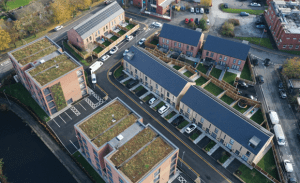
Major event for public sector construction suppliers to tackle UK’s decarbonisation challenges
Public sector construction suppliers are being invited to attend a major industry event that will discuss broad perspectives from across the sector on retrofitting at scale to decarbonise the UK’s existing built environment and deliver a net zero future. Scheduled for 28 February in Birmingham, the Retrofit for a Net Zero Future Conference promises to be a gathering of industry leaders, innovators, and experts, all committed to paving the way for a sustainable future. The conference is being spearheaded by LHC Procurement Group (LHC), a not-for-profit built environment, compliance and consultancy framework provider delivering exclusively to the public sector. Among the distinguished speakers announced for the event are Euan Durston, Regional Director at ECD Architects, and Luke Smith, Managing Director at Build Test Solutions. Durston brings with him a wealth of experience from ECD Architects, renowned for delivering retrofit projects at scale across the UK. He will present case studies showcasing successful retrofitting at scale for a net zero future, offering practical examples and lessons learned. Smith, on the other hand, will delve into the critical role of measurement and analysis to ensure that the desired outcomes for building performance and quality are met. Other speakers at the event include Karen Ashley-Seaman, Product Manager at Vaillant, who will be delving into the importance of collaboration with stakeholders in achieving net zero through retrofit initiatives. Matt Hickman, Bid Director at VINCI Facilities, will provide insights from the responsible main contractor perspective, shedding light on the intricacies of delivering net zero projects. Simon Kemp, Director of Growth and Innovation at Warmworks, will speak on simplifying procurement of large-scale retrofit projects. LHC will also lead several discussions at the event, including one by Chris Ferguson, Technical Manager, Energy Efficiency at LHC, who will address the knowledge gap challenges facing the sector in achieving net zero and discuss strategies for overcoming these hurdles. At the heart of the discussions will be LHC’s latest Decarbonisation and Retrofit (N9) framework. Developed in response to extensive market engagement, this framework is poised to assist public sector organisations in overcoming the hurdles of decarbonisation. Dean Fazackerley, Head of Technical Procurement at LHC, said the market had shown a positive response during the framework’s development phase, and explained the Group’s commitment to addressing the sector’s challenges. Dean Fazackerley said: “The conference will explore the urgent challenge of decarbonising the UK’s built environment, and the practical ways that public sector organisations can improve their buildings, such as enhancing building insulation, optimising heating systems and integrating renewable energy solutions. “Participants can look forward to discussions facilitating broad industry perspectives on areas such as control and management systems, electrical servicing, and multi-disciplinary works among other measures aimed at resolving the challenges towards a net zero future. “Collaboration is paramount in meeting this challenge, and by exchanging data, sharing best practices, and fostering innovation, we can drive meaningful change and usher in a new era of sustainability in the construction sector.” Designed to facilitate a transition to net zero, the N9 framework will offer a suite of energy efficiency and decarbonisation solutions, including consultancy services. Anticipated to launch in mid-2024, N9 holds significant importance in the journey towards achieving net carbon zero. Dean added: “This is an area of increased importance as we all strive to improve building stock, reduce operating costs, and deliver positive outcomes for occupants.” It is the most important net zero framework in development since LHC became a CLG last year and will be available nationwide through the Group’s five business units: London and South East (LSE); Consortium Procurement Construction (CPC); South West Procurement Alliance (SWPA); Welsh Procurement Alliance (WPA); and Scottish Procurement Alliance (SPA). The Retrofit for a Net Zero Future event promises attendees access to invaluable insights, best practices, and experiences in delivering retrofit and decarbonisation programs. With partners including Build Test Solutions, ECD Architects, Vaillant, Vinci Facilities, and Warmworks, the event is expected to catalyse meaningful discussions and collaborations within the sector. It will take place on 28 February at the Crowne Plaza Hotel in Birmingham. To secure your place and be a part of shaping the future of construction, visit the LHC website. Building, Design & Construction Magazine | The Choice of Industry Professionals

Solar Installation at Legrand Achieves CSR Roadmap Milestone
Legrand UK & Ireland has saved over a tonne of CO2 in a single month with the installation of a solar photovoltaic (PV) panel array on the roof of its West Bromwich site, near Birmingham. The panels were installed and commissioned in October 2023 and, before the end of November, had saved 1,087kg of CO2 emissions. This emissions reduction represents a significant milestone on Legrand’s Corporate Social Responsibility (CSR) roadmap with this installation’s annual CO2 savings projected to be in the region of 29 tonnes. The West Bromwich site serves as Legrand’s National Distribution Centre, housing a variety of Legrand products and components prior to shipping. The site is now home to 330 PV panels, each with the capacity to generate 500w as part of a 165kWP system. Legrand’s latest CSR roadmap is the fifth the company has put into practice. The environmental part of the roadmap focuses on reducing the carbon emissions generated by Legrand and its supply chain, phasing out single-use plastics and increasing the use of recycled materials. The PV installation is just one of many ways Legrand is cutting carbon. Others include procuring more sustainable components and materials for the products it manufactures and designing those products to be as energy efficient as possible in order to help lower the emissions of its customers. Pascal Stutz, CEO of Legrand UK & Ireland, said: “We are really happy with the carbon saving the PV panels have delivered for us. We’re always looking at ways to reduce our impact on the planet and a big part of that involves switching to renewable energy. As a major UK manufacturer, we understand that we have a responsibility to the environment and that means doing everything we can to lower our carbon footprint while making it easier for our customers to reduce their own Scope 3 emissions.” For the third year running, Legrand has been the recipient of the Platinum EcoVadis medal, meaning that its practices are in line with the most ambitious objective of the Paris Agreement – namely, limiting the global increase in temperatures to 1.5 °C above pre-industrial levels and achieving carbon neutrality. Pascal continued: “The health of the planet is something we take very seriously and we are dedicated to our environmental commitments. The solar power system at West Bromwich is a significant step forward and we’re looking forward to continuing our progress by making further carbon reductions in the coming months and years.” For more on Legrand’s environmental commitments, see Legrand.co.uk. Building, Design & Construction Magazine | The Choice of Industry Professionals

McLaren Construction surpasses Net Zero Targets at Landmark Leeds Logistics Hub
A pivotal logistics warehouse scheme now completed in Leeds has met and surpassed its net zero carbon construction targets, delivered by McLaren Midlands and North. Successfully achieving an embodied carbon target to practical completion lower than first proposed, ensuring a more sustainable build and reducing the carbon offset payment, McLaren Construction Midlands and North completed works on Sherburn42 – a 660,000 sq. ft. logistics warehousing space located in Sherburn-in-Elmet at the end of November, appointed by commercial real estate investor and developer, Firethorn Trust. The 37-acre Sherburn42 scheme sits adjacent to the Sherburn Enterprise Park in Leeds and comprises the construction of four Grade-A industrial units ranging from 57,750 to 280,000 sq. ft., with industrial warehouse and office space to support core building services. The design concentrated on helping occupiers reach operational sustainability targets and the project will be accredited net-zero carbon in construction by the UK Green Building Council. Set to achieve a BREEAM ‘Excellent’ rating, the logistical hub features EV charging, full PV coverage and LED office lighting, alongside 4MvApower. The Engineering Services Consultancy Ltd (ESC) was appointed by McLaren Construction Midlands and North to undertake a Whole Life Embodied Carbon assessment of the build at as-built RIBA Stage 5. The subsequent report showed that the contractor surpassed its project target of 550 kgCO2e/m2, achieving 458.32 kgCO2e/m2. Net Zero Carbon in construction is a term that refers to the energy used during the manufacturing of materials, combined with the emissions generated throughout the building’s construction, these are then offset through an internationally recognised carbon credit scheme. This was achieved following initial reductions in the embodied carbon, through a focus on material specification. At present, there is no mandatory requirement to report on Whole Life Carbon outside of London. However, the UK Government is committed to achieving Net Zero Carbon by 2050. Gary Cramp, Managing Director of McLaren Construction Midlands & North, said: “We’re proud to announce that our team has surpassed net zero carbon targets for this pivotal Leeds scheme. “Our project team worked hard to ensure the most sustainable materials were specified, liaising closely with our supply chain. While championing sustainability for the build through the reduction of embodied carbon in the project, we’ve also managed to ensure the offset payment is as low as possible for our client, Firethorn, of which we have a fantastic relationship. “Now complete, Sherburn42 will provide incredible opportunities for the region’s workforce, allowing occupiers of all sizes – from multi-national distributors to small and medium-sized enterprises, an attractive, fit-for-purpose, sustainable workspace, providing a head start on achieving their own net zero targets.” Rhiannon Butcher, Sustainability Manager of McLaren Construction Midlands and North, said: “Firethorn was the first industrial and logistics project in McLaren Construction, to achieve net zero carbon in construction. We were able to reduce the embodied carbon in construction and meet the client’s target in part through a high use of cement replacement. “The project team worked hard to collate all of the data required for this assessment, and it has been a learning process for us. As-built assessments will become more commonplace, especially as McLaren Construction works towards its own net zero carbon in construction goals – of net zero carbon for Scopes 1 & 2 by 2025 and Scope 3 by 2045. “We are creating baseline carbon assessments in this sector to provide ourselves and our clients with more robust estimates of embodied carbon from the early RIBA stages.” Hugo Briars, Development Manager at Firethorn Trust, commented: “It has been a pleasure working in close collaboration with McLaren Construction, whose team clearly shares our passion for sustainability. Their knowledge, professionalism and commitment to quality and innovation has enabled us to exceed our environmental aspirations for Sherburn42, which we have developed on behalf of the site owner, Cain International.” James Sanders, Associate Director at Firethorn Trust, added: “We’re delighted to be bringing this state-of-the-art net-zero scheme into a market that continues to witness an erosion of committed development pipeline. “Sherburn42 benefits from an excellent road network alongside an immediate and plentiful supply of labour. Coupled with its ultra-modern specification, the scheme is ideally positioned for occupiers seeking to upgrade and expand their operations, whilst benefitting from significantly reduced running costs. We’re encouraged by recent levels of occupational demand and look forward to announcing new occupier relationships as we head into the new year!” Sherburn42’s close proximity to junction 42 A1 (M) provides direct connections to Leeds, the M1, M62 and coastal ports of Hull and Grimsby, as well as a number of regional rail stations and airports. For leasing enquiries, please contact the scheme agents, Colliers, Lambert Smith Hampton or Carter Towler. Building, Design & Construction Magazine | The Choice of Industry Professionals

Newton Heath social housing development celebrates final completion
69 low carbon homes for social rent have now been completed and residents have been welcomed to their new homes on Silk Street in north Manchester. The long-term brownfield site overlooking the Rochdale Canal has been developed and brought back into use by the Council delivering 36 one-bedroom apartments, 12 two-bedroom apartments, 17 two storey, three-bedroom houses; and 4 three storey, four-bedroom houses. 16 of the apartments will be made available to people over the age of 55, who are right-sizing from larger council properties in Newton Heath, and across north Manchester. Each of the townhouses feature solar panels, a new kitchen and bathroom, generous gardens and private driveways with electric charging points. Each of the apartments have a balcony alongside shared outdoor space – and the building will be greened through living walls and living green roofs. The properties will make use of Ground Source Heat Pumps and mechanical ventilation with heat recovery to keep utility costs down for residents. The apartments have been built to HAPPI design principles that provide larger internal space as standard, which accommodate someone using a wheelchair, along with extra storage space. This means they can also be adapted to meet the needs of the tenants. Meet the neighbourhood Christine Durber – video case study available below Christine moved into her apartment in Chiffon House in September. She had lived in her four-bedroom home in Clayton for 27 years, and it was perfect for bringing up her three children. Now the kids have moved on, Christine was starting to feel uneasy living in such a big property on her own. This is where the Council’s right-sizing officer was able to help. Christine was shown a new apartment, and she was offered extra help with the move. “I fell in love with it,” Christine said. “The Council arranged the removal company for me, and I was given some money to help with the extra costs. It paid for new blinds and flooring. It was great to get that bit of help, it really took the hassle out of the move.” Christine’s apartment has been built to low carbon specifications, there is no gas supply to the property and her electric comes from a ground source heat pump. “The flat’s lovely and warm and the bills are great,” she said, “I was paying £160 a month in my old house and I’m now paying around £58, and this will come down even more in the summer because I won’t need the heating on.” Christine’s apartment was one of 16 set aside for people aged over 55 who are rightsizing into a more manageable home and the move has brought her so many benefits. “I feel very content here. I sleep better, I love the views and I can’t wait to see how they change when the summer comes. I used to rely on my kids to take me shopping, but now with so many shops on my doorstep I can do my own, I’m getting out most days and feeling more independent.” Donna Smith Donna moved into her ground floor apartment in November 2023. Donna and her husband have five grown-up children but as they moved out, their larger three-bedroom homes in Newton Heath became too much for them. Donna has suffered with arthritis for many years and the condition is worsening as she gets older. The stairs had become a daily challenge, and the large garden was too much for her to manage. The Council was able to step in and offered them a new ground floor two-bedroom apartment in the development. “I was delighted to be offered an apartment on one level. We have so much space and everything is so much easier for me.” Donna said. With everything on one level Donna no longer has stairs to worry about and the bathroom is a fully accessible wet room so that Donna no longer has to struggle to get in and out of the bath. The use of local labour, apprentices, and local suppliers has contributed to the overall impact of the scheme. A close relationship was also built with site neighbours including Bright Futures nursery with help provided towards improving outdoor spaces and equipment together with VIP visits for the nursery children. This investment is part of Manchester City Council’s commitment to build 36,000 new homes through to 2032 – part of the city’s ambitious housing strategy. 10,000 of these homes will be genuinely affordable to Manchester people, supporting our residents to live safe, happy and prosperous lives. Leader of the Council Cllr Bev Craig, said: “We are investing in our communities across the Manchester with a real focus on our district centres and affordable housing investment to meet the needs of our residents in their local areas. “Through our housing strategy we have committed to help build 36,000 new homes across the city in the next decade – and at least 10,000 of these will be genuinely affordable for Manchester people. “At this development, using Council-owned land, we have made sure that every house is available at social rent to help meet demand for high-quality affordable homes in this area – and ensure that as many people as possible can access these properties.” Cllr Gavin White, Manchester City Council’s executive member for housing and employment, said: “I have followed this development from day one – through planning and I was onsite when the first diggers arrived. This development is a great example of what we want from our affordable housing investment. “Not only are we delivering new social housing for our residents and supporting them to move from larger homes into properties that better suit their needs – we have also brought a long-term brownfield piece of public land back into use. “These low carbon homes are also cheap to run, well insulated and heated through ground source heat pumps – supporting these residents to spend less on their energy during the cost-of-living crisis. “But most importantly, we aren’t just building property

Johnson Controls named to CDP’s ‘A List’ for performance on climate change
Based on data reported through CDP’s 2023 Climate Change questionnaire, Johnson Controls is among less than 400 companies that achieved the leadership level of climate action with an ‘A’ rating. This year, a record-breaking 23,000 companies submitted responses through the CDP platform, a 24% increase in submissions from last year. Johnson Controls is again recognised for transparency and performance on climate change and named by global environmental non-profit CDP to its annual ‘A List.’ CDP holds the largest environmental database in the world and inclusion on the list underscores Johnson Controls’ unwavering focus on sustainability. Based on data reported through CDP’s 2023 Climate Change questionnaire, Johnson Controls is among less than 400 companies that achieved the leadership level of climate action with an ‘A’ rating. This year, a record-breaking 23,000 companies submitted responses through the CDP platform, a 24% increase in submissions from last year. “We are at a critical inflection point when it comes to climate change. While buildings account for nearly 40% of global emissions, the technology exists today to get to net zero through energy efficient technology, electrification, and digital optimisation,” said Johnson Controls Chief Sustainability Officer Katie McGinty. “Our ‘A’ score is a testament to the success we’ve realised in putting the technology trifecta to work in our business operations—cutting emissions and costs—and that we are delivering for our customers who are leading on both climate and business performance. We are honoured by CDP’s recognition and aim to turn the spotlight on the great opportunity there is to be seized in climate action.” Johnson Controls is recognised at the leadership level for its environmental best practices and the company received an ‘A’ in multiple scoring categories including: scope 1 & 2 emissions; scope 3 emissions; risk disclosure; opportunity disclosure and business strategy, financial planning and scenario analysis. Sherry Madera, CEO of CDP, said, “Congratulations to all the companies on CDP’s A List, and those companies that started or accelerated their journey towards environmental transparency in 2023 – we saw a 24% increase of disclosures last year and that trajectory is to be applauded. It is only by laying the groundwork of disclosure that companies can show they are serious about the vital part they play in securing a net-zero, nature-positive future. Earning a place on the A List is about more than the score. It’s an indication of high quality, complete data that equips companies with a holistic view of their environmental impact, serves as a baseline for transition plans and – crucially – enables them to follow through on their ambitions. As we move deeper into the Decade of Action, and as CDP continually raises the bar for what represents environmental leadership, the work of A List companies is never complete. We look forward to seeing all companies turn their commitments into further and more meaningful and effective action.” CDP is a global non-profit that runs the world’s environmental disclosure system for companies, cities, states and regions. CDP pioneered using capital markets and corporate procurement to motivate companies to disclose their environmental impacts, and to reduce greenhouse gas emissions, safeguard water resources and protect forests. Scores are widely used to drive investment and procurement decisions towards a zero carbon, sustainable and resilient economy. CDP is a founding member of the Science Based Targets initiative, We Mean Business Coalition, The Investor Agenda and the Net Zero Asset Managers initiative. Recent Johnson Controls Commitments and Recognition to Sustainability: To read more about Johnson Controls commitment to sustainability, please visit: https://www.johnsoncontrols.com/corporate-sustainability/environment. The full list of companies that made this year’s CDP A List is available here: https://www.cdp.net/en/companies/companies-scores. Building, Design & Construction Magazine | The Choice of Industry Professionals

Largest Passivhaus affordable housing scheme in the north west nears completion
Construction of the largest Passivhaus affordable housing scheme in the north west is nearing completion. The finishing touches are now being made at Greenhaus – a highly sustainable development of 96 homes, which is being built on Chapel Street in Salford, opposite Salford Cathedral. The first residents are expected to start moving into Greenhaus this spring. The ground-breaking development is being delivered by The English Cities Fund (ECF) – a joint venture between nationwide placemaker, Muse, Legal & General and Homes England – alongside Salford housing association Salix Homes, and supported by Salford City Council. This week, delegates from the Northern Housing Consortium (NHC) paid a visit to Greenhaus, including leaders from housing associations across the north, to find out more about how sustainable and affordable homes can be delivered on a large scale. NHC Chief Executive Tracy Harrison said: “This is a fantastic example of green homes delivering real change in the north. Projects like this cut carbon, deliver lower bills and warmer, healthier homes, as well as creating good green jobs. This benefits residents, the economy, and the environment. We need an ambitious programme of investment from the government to build on this progress.” The nine-storey development has been built to Passivhaus Classic certified standard, which is the leading low-energy design standard. Passivhaus homes offer high thermal comfort and improved air quality, providing a healthier living environment and homes that are cheaper to heat and run. The sustainable features at Greenhaus include triple glazed windows, the latest insulation technology, improved ventilation and airtightness, air source heat pumps and publicly accessible electric vehicle charging points. The one and two-bedroom homes will be available in a mix of tenures including social rent, affordable rent and rent-to-buy. Sue Sutton, Chief Executive at Salix Homes, said: “Greenhaus is the first and largest development of its kind in the region, setting the benchmark for new-build, affordable and sustainable homes that are fit-for-the-future and support our carbon neutral ambitions. “We were pleased to welcome NHC members to see the development as it nears completion and share with them our experience of how truly sustainable and affordable homes can be built at scale to help tackle the housing crisis – delivering high quality, healthier homes that are better for residents and the environment.” Passivhaus homes offer a range of health benefits for residents. The airtightness, thermal comfort and improved ventilation help protect against airborne pollutants, reduce the risk of illness associated with living in cold homes, and minimise the risk of damp, mould and condensation. Simon Hourihan, Project Director at Muse, said: “Greenhaus is a true partnership project, setting the standard for affordable, sustainable housing in the region. “We’re extremely proud of the whole team, who have been learning together and overcoming challenges to deliver high quality, Passivhaus-certified homes on a large scale. We’re looking forward to completing and residents moving in later this year, and learning more about the positive impact that low-energy homes can have on people’s lives.” Greenhaus is part of ECF’s £1bn, 50-acre Salford Central transformation being delivered in partnership with Salford City Council, and will take the overall percentage of affordable homes delivered by ECF to 25% across the Chapel Street area of the masterplan. The homes are being built by lead contractor Eric Wright Construction and were designed by architect Buttress. Andy Avery, Director at Buttress added: “This milestone is a testament to the team’s vision and skill in designing and delivering innovative and sustainable housing solutions. Buttress’ commitment to Passivhaus design illustrates our dedication to environmental responsibility, creating aesthetically pleasing yet, healthier and affordable places to live for the people of Salford.” Salix Homes secured funding from NatWest, along with grants from Homes England and Greater Manchester Combined Authority (GMCA) to help fund the multi-million-pound scheme. Building, Design & Construction Magazine | The Choice of Industry Professionals

